Governance Plan for East Timor Solar Plant Project Report
VerifiedAdded on 2023/06/03
|8
|1821
|207
Report
AI Summary
This report presents a comprehensive governance plan for the East Timor Solar Plant project, focusing on cost and schedule monitoring, reporting structures, and project governance meetings. The report recommends Earned Value Analysis (EVA) for tracking costs and schedules, justifying its selection based on its mathematical approach and ability to consider project scope, schedule, and costs. It details the advantages of EVA, such as facilitating continuous improvement, while also acknowledging its limitations regarding quality assessment. The report outlines the format and structure for project reports, emphasizing the use of figures and numbers, and specifying the inclusion of key sections. It also defines the frequency and attendees of project governance board meetings and details the structure of reports shared with the CEO and Project Board. The report references several sources to support the methodologies and approaches discussed, ensuring a well-researched and structured governance plan for the project.
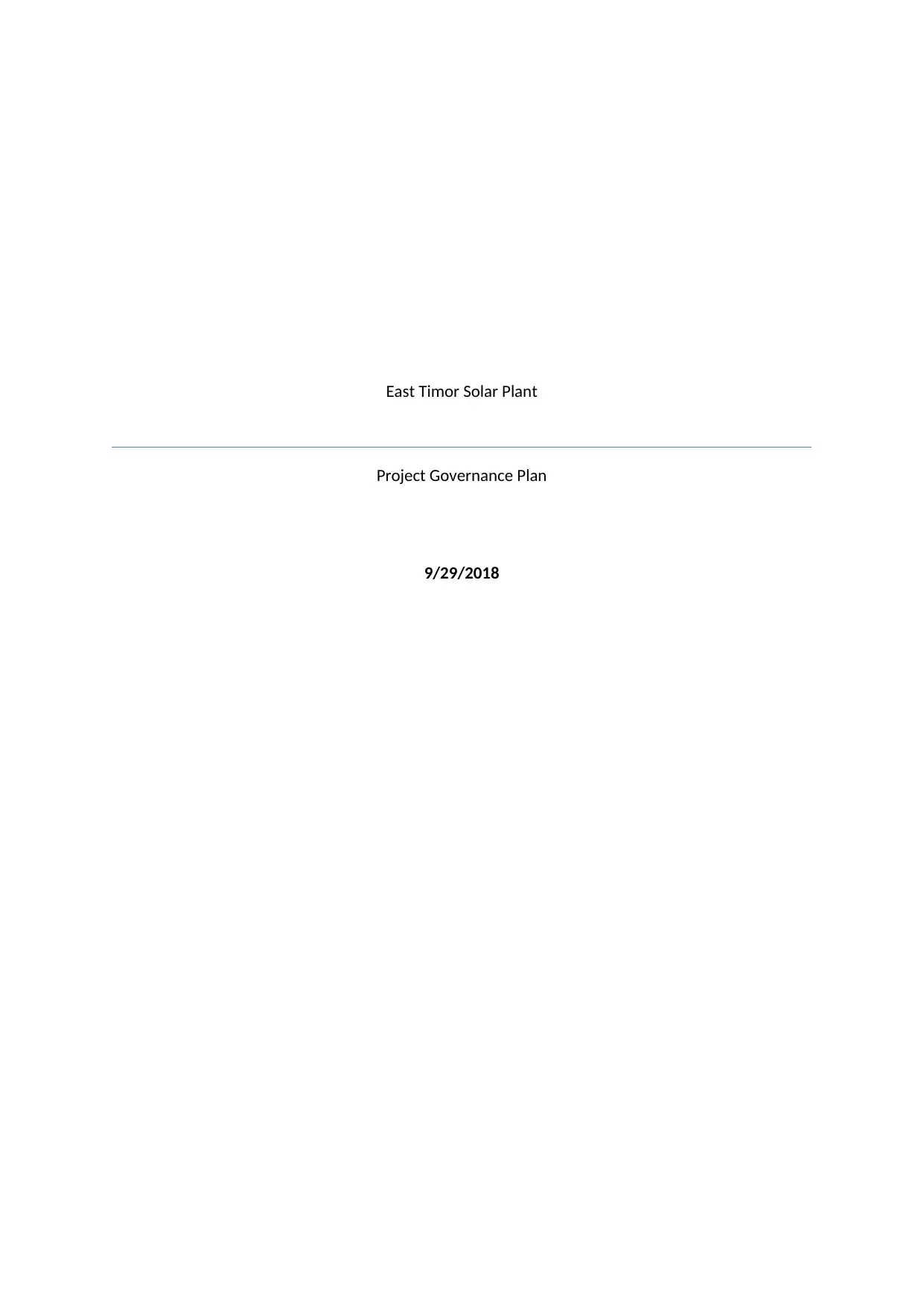
East Timor Solar Plant
Project Governance Plan
9/29/2018
Project Governance Plan
9/29/2018
Paraphrase This Document
Need a fresh take? Get an instant paraphrase of this document with our AI Paraphraser
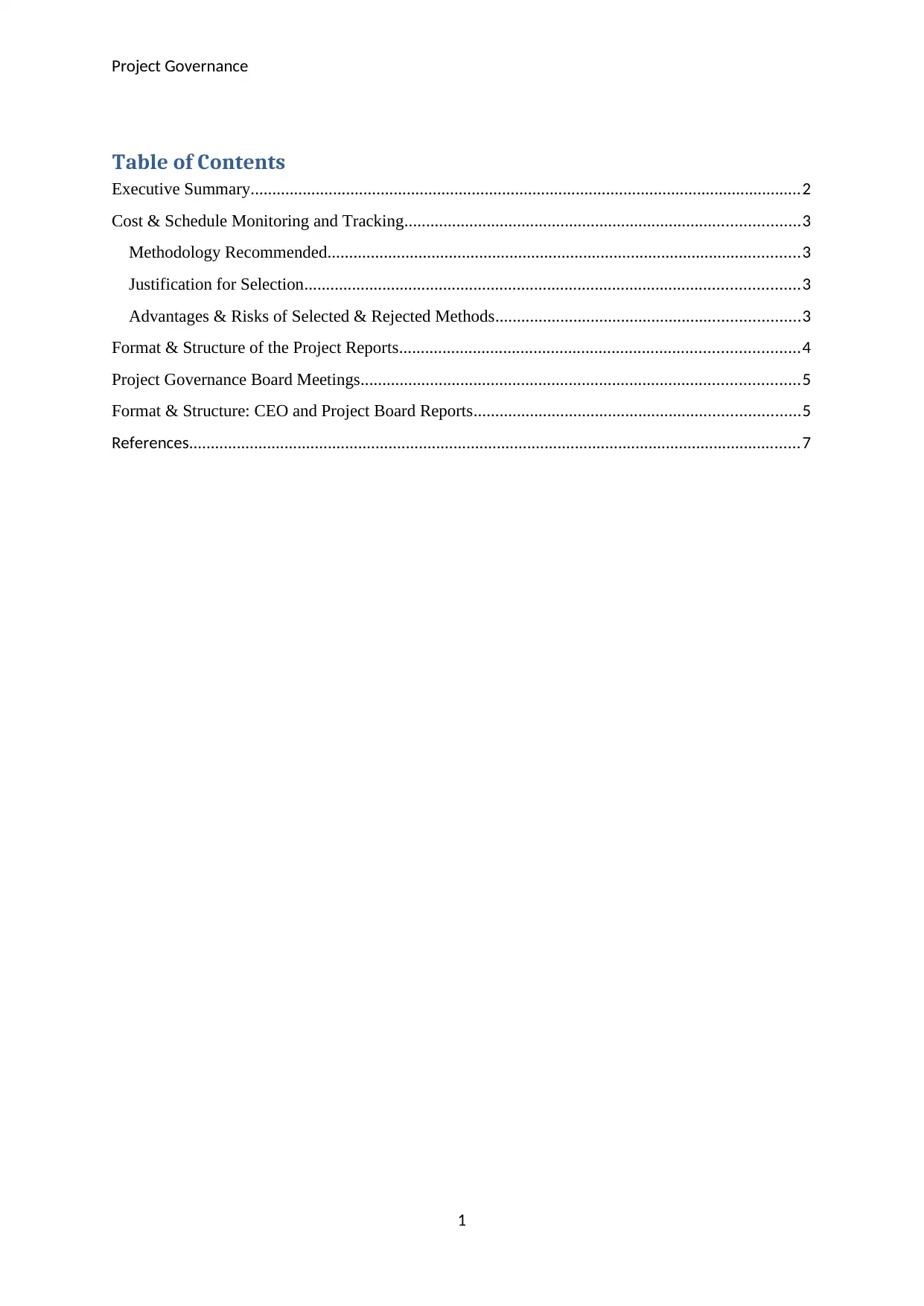
Project Governance
Table of Contents
Executive Summary...............................................................................................................................2
Cost & Schedule Monitoring and Tracking...........................................................................................3
Methodology Recommended.............................................................................................................3
Justification for Selection..................................................................................................................3
Advantages & Risks of Selected & Rejected Methods......................................................................3
Format & Structure of the Project Reports............................................................................................4
Project Governance Board Meetings.....................................................................................................5
Format & Structure: CEO and Project Board Reports...........................................................................5
References.............................................................................................................................................7
1
Table of Contents
Executive Summary...............................................................................................................................2
Cost & Schedule Monitoring and Tracking...........................................................................................3
Methodology Recommended.............................................................................................................3
Justification for Selection..................................................................................................................3
Advantages & Risks of Selected & Rejected Methods......................................................................3
Format & Structure of the Project Reports............................................................................................4
Project Governance Board Meetings.....................................................................................................5
Format & Structure: CEO and Project Board Reports...........................................................................5
References.............................................................................................................................................7
1
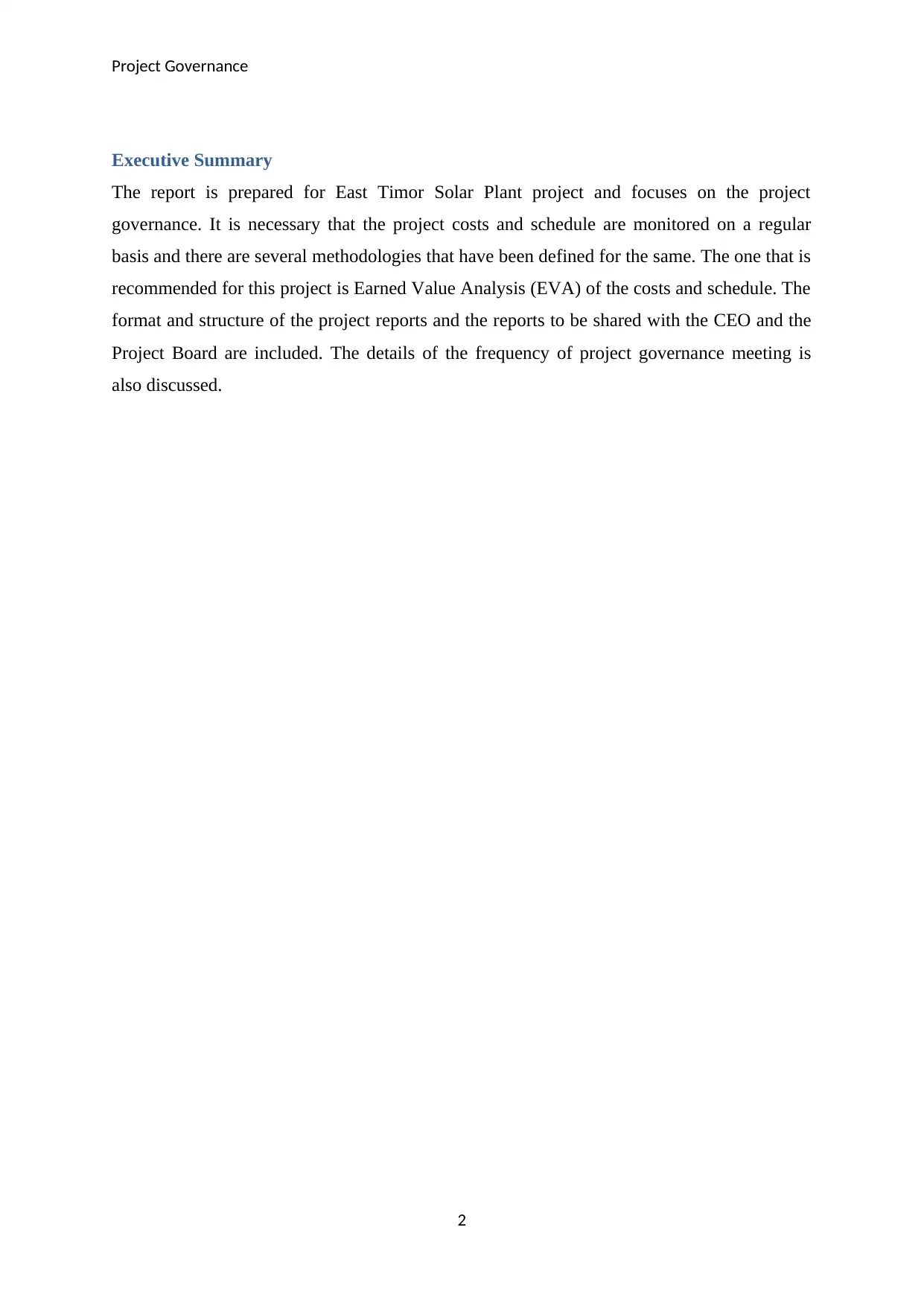
Project Governance
Executive Summary
The report is prepared for East Timor Solar Plant project and focuses on the project
governance. It is necessary that the project costs and schedule are monitored on a regular
basis and there are several methodologies that have been defined for the same. The one that is
recommended for this project is Earned Value Analysis (EVA) of the costs and schedule. The
format and structure of the project reports and the reports to be shared with the CEO and the
Project Board are included. The details of the frequency of project governance meeting is
also discussed.
2
Executive Summary
The report is prepared for East Timor Solar Plant project and focuses on the project
governance. It is necessary that the project costs and schedule are monitored on a regular
basis and there are several methodologies that have been defined for the same. The one that is
recommended for this project is Earned Value Analysis (EVA) of the costs and schedule. The
format and structure of the project reports and the reports to be shared with the CEO and the
Project Board are included. The details of the frequency of project governance meeting is
also discussed.
2
⊘ This is a preview!⊘
Do you want full access?
Subscribe today to unlock all pages.

Trusted by 1+ million students worldwide
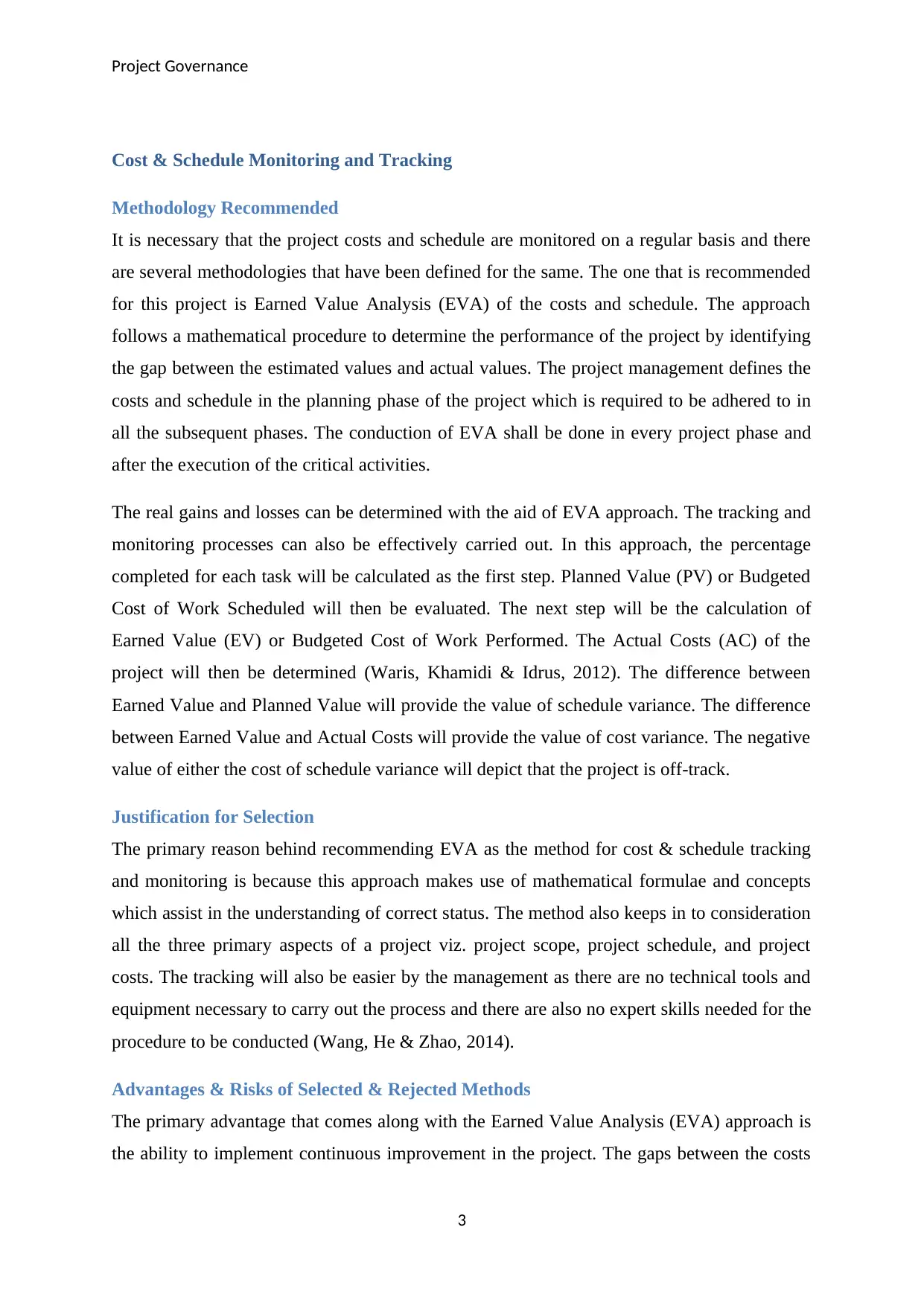
Project Governance
Cost & Schedule Monitoring and Tracking
Methodology Recommended
It is necessary that the project costs and schedule are monitored on a regular basis and there
are several methodologies that have been defined for the same. The one that is recommended
for this project is Earned Value Analysis (EVA) of the costs and schedule. The approach
follows a mathematical procedure to determine the performance of the project by identifying
the gap between the estimated values and actual values. The project management defines the
costs and schedule in the planning phase of the project which is required to be adhered to in
all the subsequent phases. The conduction of EVA shall be done in every project phase and
after the execution of the critical activities.
The real gains and losses can be determined with the aid of EVA approach. The tracking and
monitoring processes can also be effectively carried out. In this approach, the percentage
completed for each task will be calculated as the first step. Planned Value (PV) or Budgeted
Cost of Work Scheduled will then be evaluated. The next step will be the calculation of
Earned Value (EV) or Budgeted Cost of Work Performed. The Actual Costs (AC) of the
project will then be determined (Waris, Khamidi & Idrus, 2012). The difference between
Earned Value and Planned Value will provide the value of schedule variance. The difference
between Earned Value and Actual Costs will provide the value of cost variance. The negative
value of either the cost of schedule variance will depict that the project is off-track.
Justification for Selection
The primary reason behind recommending EVA as the method for cost & schedule tracking
and monitoring is because this approach makes use of mathematical formulae and concepts
which assist in the understanding of correct status. The method also keeps in to consideration
all the three primary aspects of a project viz. project scope, project schedule, and project
costs. The tracking will also be easier by the management as there are no technical tools and
equipment necessary to carry out the process and there are also no expert skills needed for the
procedure to be conducted (Wang, He & Zhao, 2014).
Advantages & Risks of Selected & Rejected Methods
The primary advantage that comes along with the Earned Value Analysis (EVA) approach is
the ability to implement continuous improvement in the project. The gaps between the costs
3
Cost & Schedule Monitoring and Tracking
Methodology Recommended
It is necessary that the project costs and schedule are monitored on a regular basis and there
are several methodologies that have been defined for the same. The one that is recommended
for this project is Earned Value Analysis (EVA) of the costs and schedule. The approach
follows a mathematical procedure to determine the performance of the project by identifying
the gap between the estimated values and actual values. The project management defines the
costs and schedule in the planning phase of the project which is required to be adhered to in
all the subsequent phases. The conduction of EVA shall be done in every project phase and
after the execution of the critical activities.
The real gains and losses can be determined with the aid of EVA approach. The tracking and
monitoring processes can also be effectively carried out. In this approach, the percentage
completed for each task will be calculated as the first step. Planned Value (PV) or Budgeted
Cost of Work Scheduled will then be evaluated. The next step will be the calculation of
Earned Value (EV) or Budgeted Cost of Work Performed. The Actual Costs (AC) of the
project will then be determined (Waris, Khamidi & Idrus, 2012). The difference between
Earned Value and Planned Value will provide the value of schedule variance. The difference
between Earned Value and Actual Costs will provide the value of cost variance. The negative
value of either the cost of schedule variance will depict that the project is off-track.
Justification for Selection
The primary reason behind recommending EVA as the method for cost & schedule tracking
and monitoring is because this approach makes use of mathematical formulae and concepts
which assist in the understanding of correct status. The method also keeps in to consideration
all the three primary aspects of a project viz. project scope, project schedule, and project
costs. The tracking will also be easier by the management as there are no technical tools and
equipment necessary to carry out the process and there are also no expert skills needed for the
procedure to be conducted (Wang, He & Zhao, 2014).
Advantages & Risks of Selected & Rejected Methods
The primary advantage that comes along with the Earned Value Analysis (EVA) approach is
the ability to implement continuous improvement in the project. The gaps between the costs
3
Paraphrase This Document
Need a fresh take? Get an instant paraphrase of this document with our AI Paraphraser
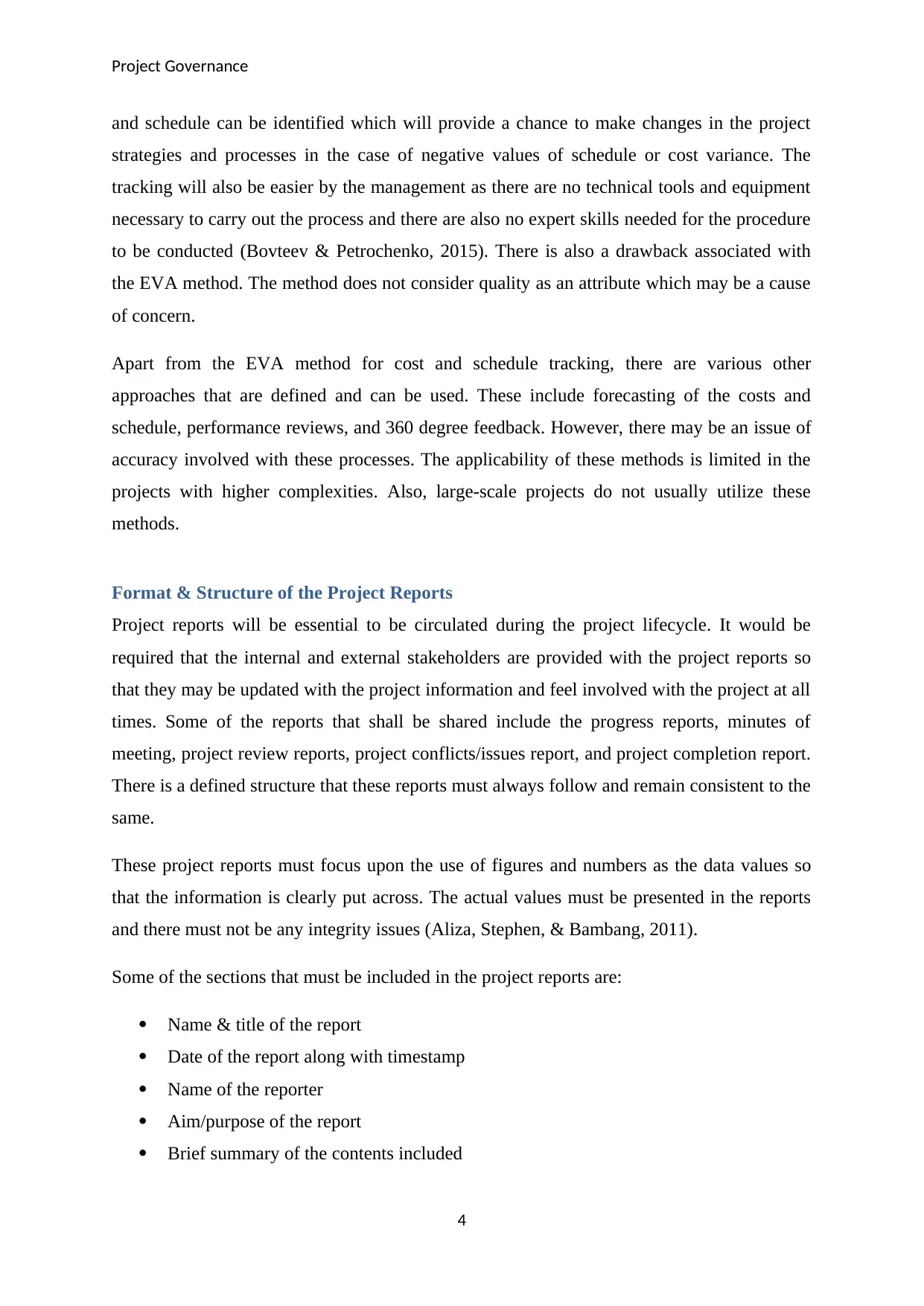
Project Governance
and schedule can be identified which will provide a chance to make changes in the project
strategies and processes in the case of negative values of schedule or cost variance. The
tracking will also be easier by the management as there are no technical tools and equipment
necessary to carry out the process and there are also no expert skills needed for the procedure
to be conducted (Bovteev & Petrochenko, 2015). There is also a drawback associated with
the EVA method. The method does not consider quality as an attribute which may be a cause
of concern.
Apart from the EVA method for cost and schedule tracking, there are various other
approaches that are defined and can be used. These include forecasting of the costs and
schedule, performance reviews, and 360 degree feedback. However, there may be an issue of
accuracy involved with these processes. The applicability of these methods is limited in the
projects with higher complexities. Also, large-scale projects do not usually utilize these
methods.
Format & Structure of the Project Reports
Project reports will be essential to be circulated during the project lifecycle. It would be
required that the internal and external stakeholders are provided with the project reports so
that they may be updated with the project information and feel involved with the project at all
times. Some of the reports that shall be shared include the progress reports, minutes of
meeting, project review reports, project conflicts/issues report, and project completion report.
There is a defined structure that these reports must always follow and remain consistent to the
same.
These project reports must focus upon the use of figures and numbers as the data values so
that the information is clearly put across. The actual values must be presented in the reports
and there must not be any integrity issues (Aliza, Stephen, & Bambang, 2011).
Some of the sections that must be included in the project reports are:
Name & title of the report
Date of the report along with timestamp
Name of the reporter
Aim/purpose of the report
Brief summary of the contents included
4
and schedule can be identified which will provide a chance to make changes in the project
strategies and processes in the case of negative values of schedule or cost variance. The
tracking will also be easier by the management as there are no technical tools and equipment
necessary to carry out the process and there are also no expert skills needed for the procedure
to be conducted (Bovteev & Petrochenko, 2015). There is also a drawback associated with
the EVA method. The method does not consider quality as an attribute which may be a cause
of concern.
Apart from the EVA method for cost and schedule tracking, there are various other
approaches that are defined and can be used. These include forecasting of the costs and
schedule, performance reviews, and 360 degree feedback. However, there may be an issue of
accuracy involved with these processes. The applicability of these methods is limited in the
projects with higher complexities. Also, large-scale projects do not usually utilize these
methods.
Format & Structure of the Project Reports
Project reports will be essential to be circulated during the project lifecycle. It would be
required that the internal and external stakeholders are provided with the project reports so
that they may be updated with the project information and feel involved with the project at all
times. Some of the reports that shall be shared include the progress reports, minutes of
meeting, project review reports, project conflicts/issues report, and project completion report.
There is a defined structure that these reports must always follow and remain consistent to the
same.
These project reports must focus upon the use of figures and numbers as the data values so
that the information is clearly put across. The actual values must be presented in the reports
and there must not be any integrity issues (Aliza, Stephen, & Bambang, 2011).
Some of the sections that must be included in the project reports are:
Name & title of the report
Date of the report along with timestamp
Name of the reporter
Aim/purpose of the report
Brief summary of the contents included
4
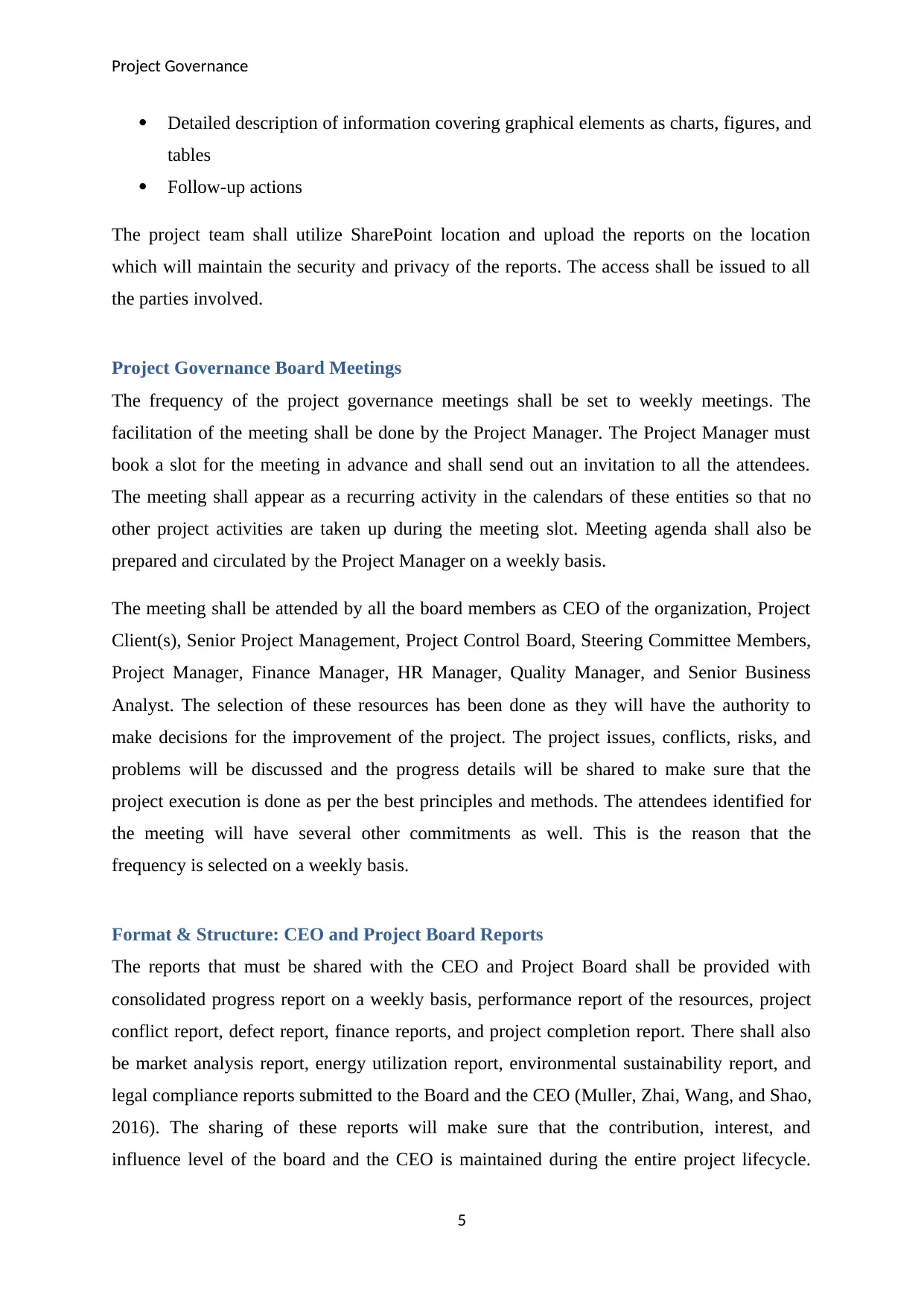
Project Governance
Detailed description of information covering graphical elements as charts, figures, and
tables
Follow-up actions
The project team shall utilize SharePoint location and upload the reports on the location
which will maintain the security and privacy of the reports. The access shall be issued to all
the parties involved.
Project Governance Board Meetings
The frequency of the project governance meetings shall be set to weekly meetings. The
facilitation of the meeting shall be done by the Project Manager. The Project Manager must
book a slot for the meeting in advance and shall send out an invitation to all the attendees.
The meeting shall appear as a recurring activity in the calendars of these entities so that no
other project activities are taken up during the meeting slot. Meeting agenda shall also be
prepared and circulated by the Project Manager on a weekly basis.
The meeting shall be attended by all the board members as CEO of the organization, Project
Client(s), Senior Project Management, Project Control Board, Steering Committee Members,
Project Manager, Finance Manager, HR Manager, Quality Manager, and Senior Business
Analyst. The selection of these resources has been done as they will have the authority to
make decisions for the improvement of the project. The project issues, conflicts, risks, and
problems will be discussed and the progress details will be shared to make sure that the
project execution is done as per the best principles and methods. The attendees identified for
the meeting will have several other commitments as well. This is the reason that the
frequency is selected on a weekly basis.
Format & Structure: CEO and Project Board Reports
The reports that must be shared with the CEO and Project Board shall be provided with
consolidated progress report on a weekly basis, performance report of the resources, project
conflict report, defect report, finance reports, and project completion report. There shall also
be market analysis report, energy utilization report, environmental sustainability report, and
legal compliance reports submitted to the Board and the CEO (Muller, Zhai, Wang, and Shao,
2016). The sharing of these reports will make sure that the contribution, interest, and
influence level of the board and the CEO is maintained during the entire project lifecycle.
5
Detailed description of information covering graphical elements as charts, figures, and
tables
Follow-up actions
The project team shall utilize SharePoint location and upload the reports on the location
which will maintain the security and privacy of the reports. The access shall be issued to all
the parties involved.
Project Governance Board Meetings
The frequency of the project governance meetings shall be set to weekly meetings. The
facilitation of the meeting shall be done by the Project Manager. The Project Manager must
book a slot for the meeting in advance and shall send out an invitation to all the attendees.
The meeting shall appear as a recurring activity in the calendars of these entities so that no
other project activities are taken up during the meeting slot. Meeting agenda shall also be
prepared and circulated by the Project Manager on a weekly basis.
The meeting shall be attended by all the board members as CEO of the organization, Project
Client(s), Senior Project Management, Project Control Board, Steering Committee Members,
Project Manager, Finance Manager, HR Manager, Quality Manager, and Senior Business
Analyst. The selection of these resources has been done as they will have the authority to
make decisions for the improvement of the project. The project issues, conflicts, risks, and
problems will be discussed and the progress details will be shared to make sure that the
project execution is done as per the best principles and methods. The attendees identified for
the meeting will have several other commitments as well. This is the reason that the
frequency is selected on a weekly basis.
Format & Structure: CEO and Project Board Reports
The reports that must be shared with the CEO and Project Board shall be provided with
consolidated progress report on a weekly basis, performance report of the resources, project
conflict report, defect report, finance reports, and project completion report. There shall also
be market analysis report, energy utilization report, environmental sustainability report, and
legal compliance reports submitted to the Board and the CEO (Muller, Zhai, Wang, and Shao,
2016). The sharing of these reports will make sure that the contribution, interest, and
influence level of the board and the CEO is maintained during the entire project lifecycle.
5
⊘ This is a preview!⊘
Do you want full access?
Subscribe today to unlock all pages.

Trusted by 1+ million students worldwide
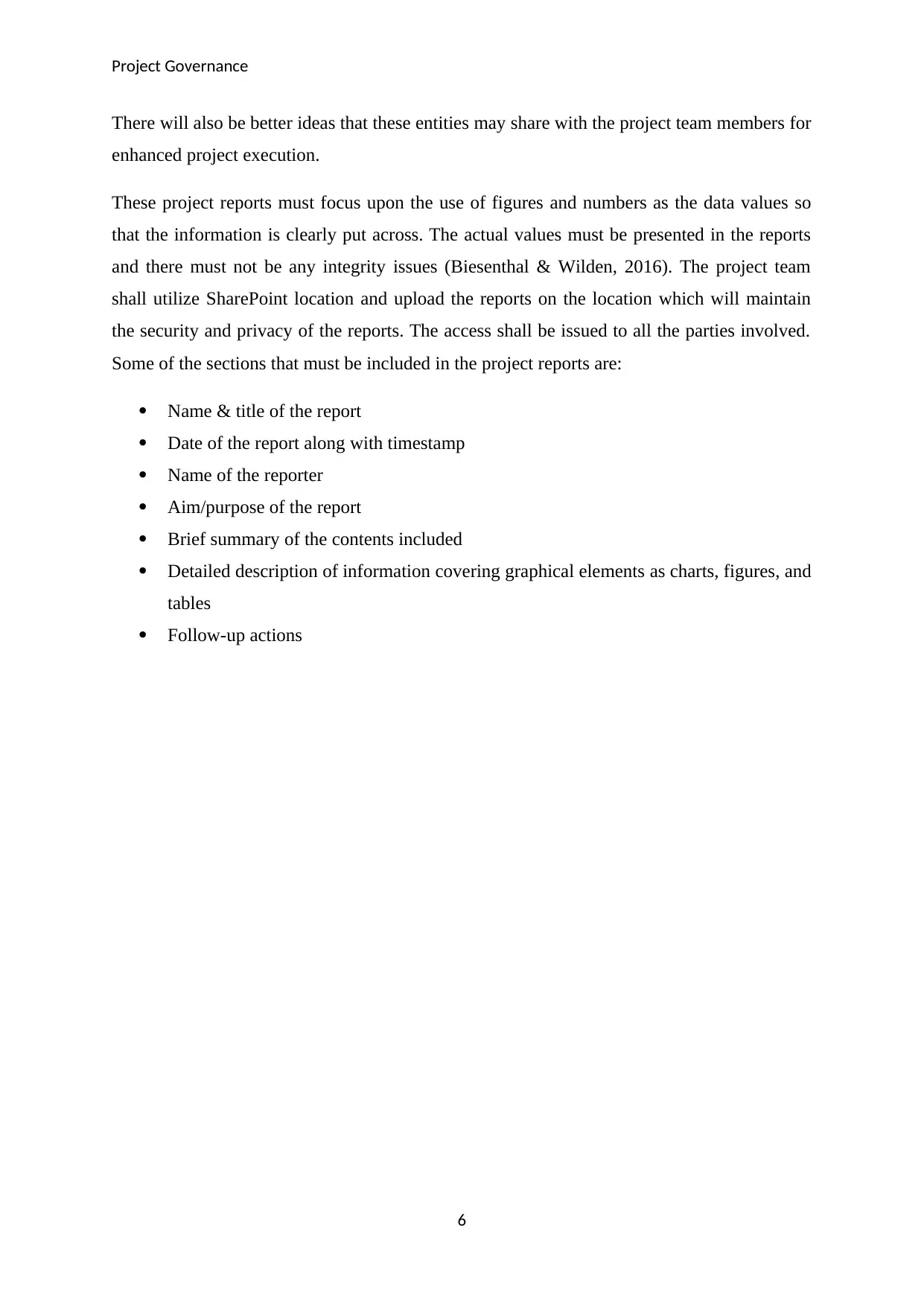
Project Governance
There will also be better ideas that these entities may share with the project team members for
enhanced project execution.
These project reports must focus upon the use of figures and numbers as the data values so
that the information is clearly put across. The actual values must be presented in the reports
and there must not be any integrity issues (Biesenthal & Wilden, 2016). The project team
shall utilize SharePoint location and upload the reports on the location which will maintain
the security and privacy of the reports. The access shall be issued to all the parties involved.
Some of the sections that must be included in the project reports are:
Name & title of the report
Date of the report along with timestamp
Name of the reporter
Aim/purpose of the report
Brief summary of the contents included
Detailed description of information covering graphical elements as charts, figures, and
tables
Follow-up actions
6
There will also be better ideas that these entities may share with the project team members for
enhanced project execution.
These project reports must focus upon the use of figures and numbers as the data values so
that the information is clearly put across. The actual values must be presented in the reports
and there must not be any integrity issues (Biesenthal & Wilden, 2016). The project team
shall utilize SharePoint location and upload the reports on the location which will maintain
the security and privacy of the reports. The access shall be issued to all the parties involved.
Some of the sections that must be included in the project reports are:
Name & title of the report
Date of the report along with timestamp
Name of the reporter
Aim/purpose of the report
Brief summary of the contents included
Detailed description of information covering graphical elements as charts, figures, and
tables
Follow-up actions
6
Paraphrase This Document
Need a fresh take? Get an instant paraphrase of this document with our AI Paraphraser
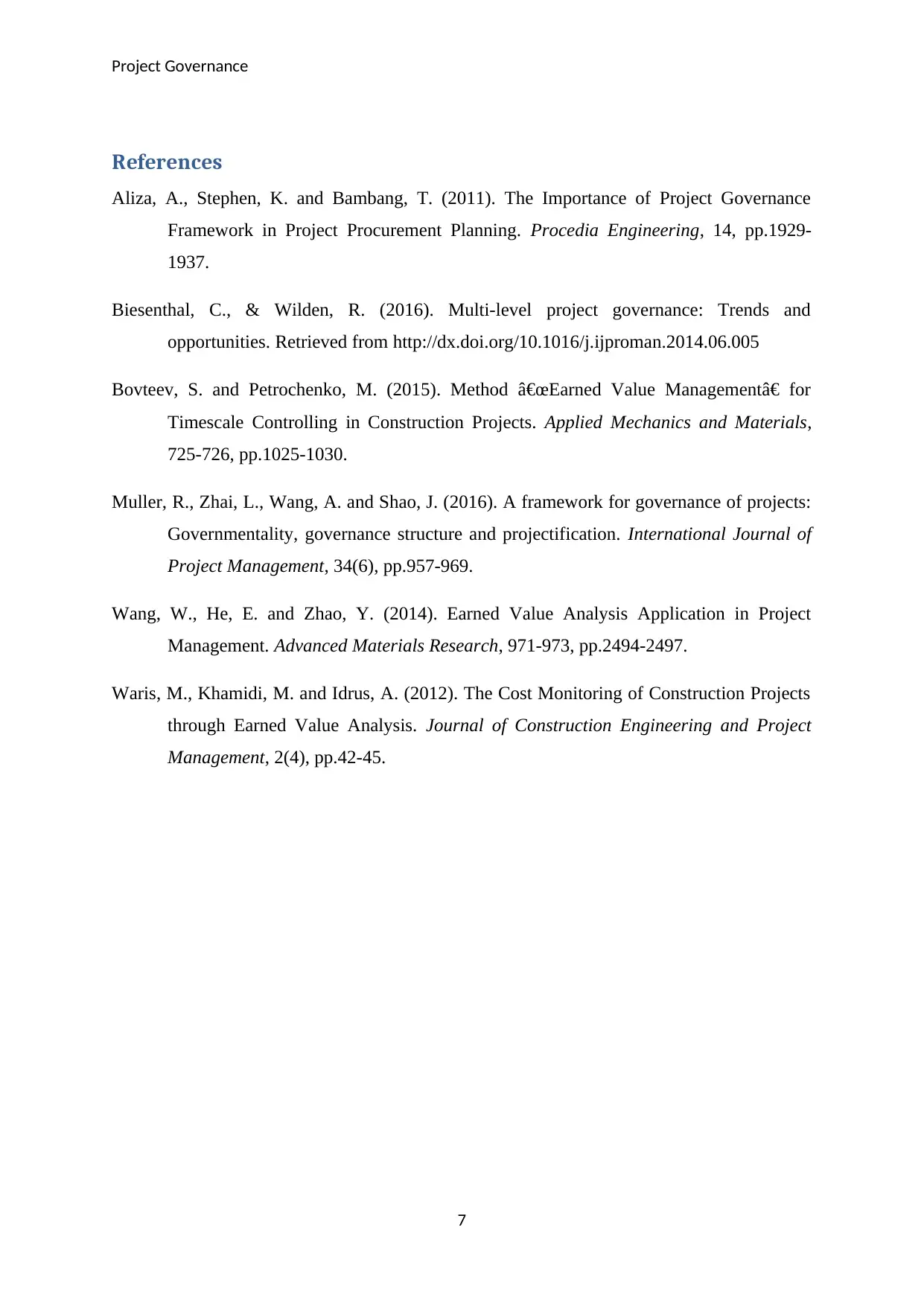
Project Governance
References
Aliza, A., Stephen, K. and Bambang, T. (2011). The Importance of Project Governance
Framework in Project Procurement Planning. Procedia Engineering, 14, pp.1929-
1937.
Biesenthal, C., & Wilden, R. (2016). Multi-level project governance: Trends and
opportunities. Retrieved from http://dx.doi.org/10.1016/j.ijproman.2014.06.005
Bovteev, S. and Petrochenko, M. (2015). Method “Earned Value Management†for
Timescale Controlling in Construction Projects. Applied Mechanics and Materials,
725-726, pp.1025-1030.
Muller, R., Zhai, L., Wang, A. and Shao, J. (2016). A framework for governance of projects:
Governmentality, governance structure and projectification. International Journal of
Project Management, 34(6), pp.957-969.
Wang, W., He, E. and Zhao, Y. (2014). Earned Value Analysis Application in Project
Management. Advanced Materials Research, 971-973, pp.2494-2497.
Waris, M., Khamidi, M. and Idrus, A. (2012). The Cost Monitoring of Construction Projects
through Earned Value Analysis. Journal of Construction Engineering and Project
Management, 2(4), pp.42-45.
7
References
Aliza, A., Stephen, K. and Bambang, T. (2011). The Importance of Project Governance
Framework in Project Procurement Planning. Procedia Engineering, 14, pp.1929-
1937.
Biesenthal, C., & Wilden, R. (2016). Multi-level project governance: Trends and
opportunities. Retrieved from http://dx.doi.org/10.1016/j.ijproman.2014.06.005
Bovteev, S. and Petrochenko, M. (2015). Method “Earned Value Management†for
Timescale Controlling in Construction Projects. Applied Mechanics and Materials,
725-726, pp.1025-1030.
Muller, R., Zhai, L., Wang, A. and Shao, J. (2016). A framework for governance of projects:
Governmentality, governance structure and projectification. International Journal of
Project Management, 34(6), pp.957-969.
Wang, W., He, E. and Zhao, Y. (2014). Earned Value Analysis Application in Project
Management. Advanced Materials Research, 971-973, pp.2494-2497.
Waris, M., Khamidi, M. and Idrus, A. (2012). The Cost Monitoring of Construction Projects
through Earned Value Analysis. Journal of Construction Engineering and Project
Management, 2(4), pp.42-45.
7
1 out of 8
Related Documents
Your All-in-One AI-Powered Toolkit for Academic Success.
+13062052269
info@desklib.com
Available 24*7 on WhatsApp / Email
![[object Object]](/_next/static/media/star-bottom.7253800d.svg)
Unlock your academic potential
Copyright © 2020–2025 A2Z Services. All Rights Reserved. Developed and managed by ZUCOL.




